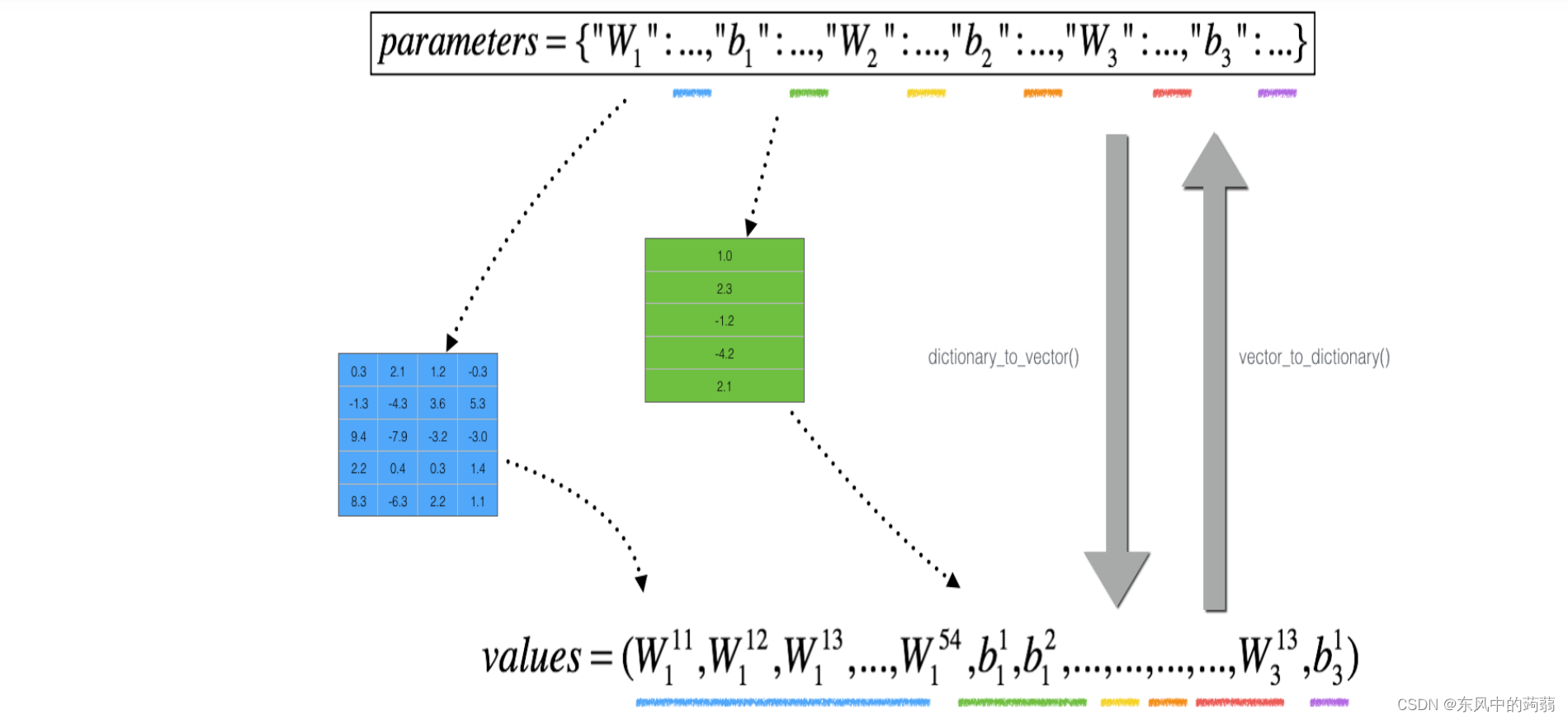文章目录
3 - How does Gradient Checking work?
Backpropagation computes the gradients ∂ J ∂ θ \frac{\partial J}{\partial \theta} ∂θ∂J, where θ \theta θ denotes the parameters of the model. J J J is computed using forward propagation and your loss function.
Because forward propagation is relatively easy to implement, you’re confident you got that right, and so you’re almost 100% sure that you’re computing the cost J J J correctly. Thus, you can use your code for computing J J J to verify the code for computing ∂ J ∂ θ \frac{\partial J}{\partial \theta} ∂θ∂J.
Let’s look back at the definition of a derivative (or gradient): ∂ J ∂ θ = lim ε → 0 J ( θ + ε ) − J ( θ − ε ) 2 ε \frac{\partial J}{\partial \theta} = \lim_{\varepsilon \to 0} \frac{J(\theta + \varepsilon) - J(\theta - \varepsilon)}{2 \varepsilon} ∂θ∂J=ε→0lim2εJ(θ+ε)−J(θ−ε)
If you’re not familiar with the “ lim ε → 0 \displaystyle \lim_{\varepsilon \to 0} ε→0lim” notation, it’s just a way of saying “when ε \varepsilon ε is really, really small.”
You know the following:
∂ J ∂ θ \frac{\partial J}{\partial \theta} ∂θ∂J is what you want to make sure you’re computing correctly.
You can compute J ( θ + ε ) J(\theta + \varepsilon) J(θ+ε) and J ( θ − ε ) J(\theta - \varepsilon) J(θ−ε) (in the case that θ \theta θ is a real number), since you’re confident your implementation for J J J is correct.
Let’s use equation (1) and a small value for ε \varepsilon ε to convince your CEO that your code for computing ∂ J ∂ θ \frac{\partial J}{\partial \theta} ∂θ∂J is correct!
- 主要方法就是将所有的参数压缩为一个很大的变量
θ
\theta
θ,将神经网络看作为一个函数
F
(
θ
∣
Y
)
F(\theta|Y)
F(θ∣Y),求参数的过程就是用微积分偏导数的定义
g r a d = lim ϵ → 0 F ( θ + ϵ ) − F ( θ − ϵ ) 2 ϵ grad = \lim_{\epsilon\rightarrow0}{\frac{F(\theta+\epsilon)-F(\theta-\epsilon)}{2\epsilon}} grad=ϵ→0lim2ϵF(θ+ϵ)−F(θ−ϵ)
使用上述公式对每一个参数进行检验。这非常消耗时间
# GRADED FUNCTION: gradient_check_n
def gradient_check_n(parameters, gradients, X, Y, epsilon=1e-7, print_msg=False):
"""
Checks if backward_propagation_n computes correctly the gradient of the cost output by forward_propagation_n
Arguments:
parameters -- python dictionary containing your parameters "W1", "b1", "W2", "b2", "W3", "b3":
grad -- output of backward_propagation_n, contains gradients of the cost with respect to the parameters.
x -- input datapoint, of shape (input size, 1)
y -- true "label"
epsilon -- tiny shift to the input to compute approximated gradient with formula(1)
Returns:
difference -- difference (2) between the approximated gradient and the backward propagation gradient
"""
# Set-up variables
parameters_values, _ = dictionary_to_vector(parameters)
grad = gradients_to_vector(gradients)
num_parameters = parameters_values.shape[0]
J_plus = np.zeros((num_parameters, 1))
J_minus = np.zeros((num_parameters, 1))
gradapprox = np.zeros((num_parameters, 1))
# Compute gradapprox
for i in range(num_parameters):
# Compute J_plus[i]. Inputs: "parameters_values, epsilon". Output = "J_plus[i]".
# "_" is used because the function you have to outputs two parameters but we only care about the first one
#(approx. 3 lines)
# theta_plus = # Step 1
# theta_plus[i] = # Step 2
# J_plus[i], _ = # Step 3
# YOUR CODE STARTS HERE
theta_plus = np.copy(parameters_values)
theta_plus[i] = theta_plus[i] + epsilon
J_plus[i],_ = forward_propagation_n(X,Y,vector_to_dictionary(theta_plus))
# YOUR CODE ENDS HERE
# Compute J_minus[i]. Inputs: "parameters_values, epsilon". Output = "J_minus[i]".
#(approx. 3 lines)
# theta_minus = # Step 1
# theta_minus[i] = # Step 2
# J_minus[i], _ = # Step 3
# YOUR CODE STARTS HERE
theta_minus = np.copy(parameters_values)
theta_minus[i] = theta_minus[i]-epsilon
J_minus[i],_ = forward_propagation_n(X,Y,vector_to_dictionary(theta_minus))
# YOUR CODE ENDS HERE
# Compute gradapprox[i]
# (approx. 1 line)
# gradapprox[i] =
# YOUR CODE STARTS HERE
gradapprox[i] = (J_plus[i]-J_minus[i])/(2*epsilon)
# YOUR CODE ENDS HERE
# Compare gradapprox to backward propagation gradients by computing difference.
# (approx. 1 line)
# numerator = # Step 1'
# denominator = # Step 2'
# difference = # Step 3'
# YOUR CODE STARTS HERE
numerator = np.linalg.norm(grad-gradapprox)
denominator = np.linalg.norm(grad)+np.linalg.norm(gradapprox)
difference = numerator/denominator
print(vector_to_dictionary(grad-gradapprox))
# YOUR CODE ENDS HERE
if print_msg:
if difference > 2e-7:
print ("\033[93m" + "There is a mistake in the backward propagation! difference = " + str(difference) + "\033[0m")
else:
print ("\033[92m" + "Your backward propagation works perfectly fine! difference = " + str(difference) + "\033[0m")
return difference

def dictionary_to_vector(parameters):
"""
Roll all our parameters dictionary into a single vector satisfying our specific required shape.
"""
keys = []
count = 0
for key in ["W1", "b1", "W2", "b2", "W3", "b3"]:
# flatten parameter
new_vector = np.reshape(parameters[key], (-1, 1))
keys = keys + [key] * new_vector.shape[0]
if count == 0:
theta = new_vector
else:
theta = np.concatenate((theta, new_vector), axis=0)
count = count + 1
return theta, keys
def vector_to_dictionary(theta):
"""
Unroll all our parameters dictionary from a single vector satisfying our specific required shape.
"""
parameters = {}
parameters["W1"] = theta[: 20].reshape((5, 4))
parameters["b1"] = theta[20: 25].reshape((5, 1))
parameters["W2"] = theta[25: 40].reshape((3, 5))
parameters["b2"] = theta[40: 43].reshape((3, 1))
parameters["W3"] = theta[43: 46].reshape((1, 3))
parameters["b3"] = theta[46: 47].reshape((1, 1))
return parameters
如果发现存在错误,可以将使用
vector_to_dictionary(grad-gradapprox)
将结果打印出来,从神经网络后面的参数往前观察,发现的第一个不为0的参数就是错误。
需要注意的是grad checking不能用于具有dropout正则化的网络,可以用于penalty的正则化。





















 569
569











 被折叠的 条评论
为什么被折叠?
被折叠的 条评论
为什么被折叠?










